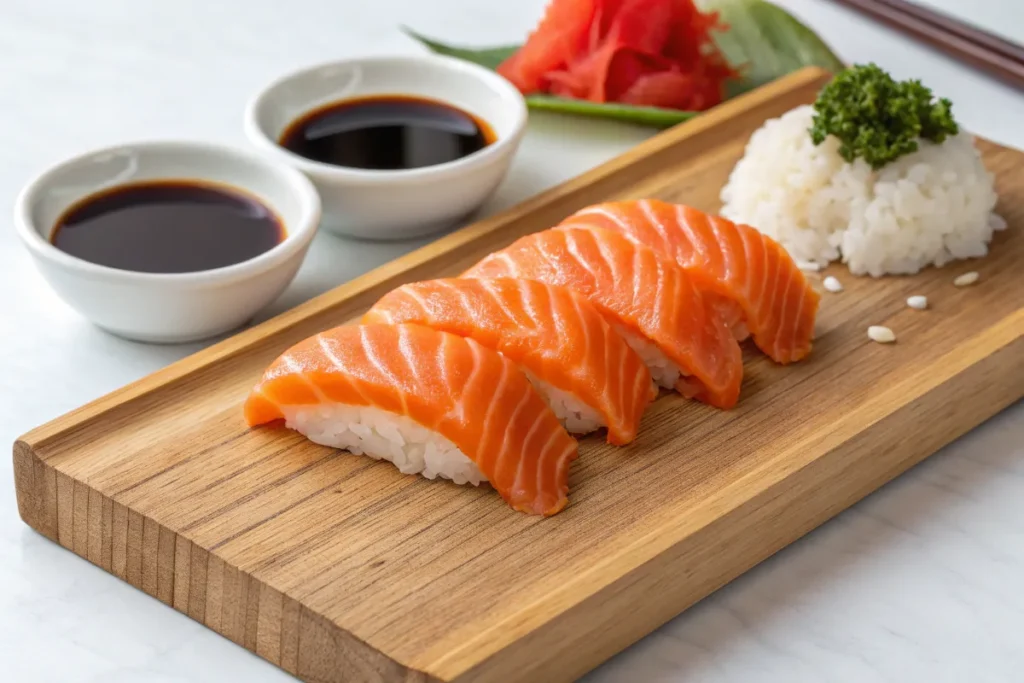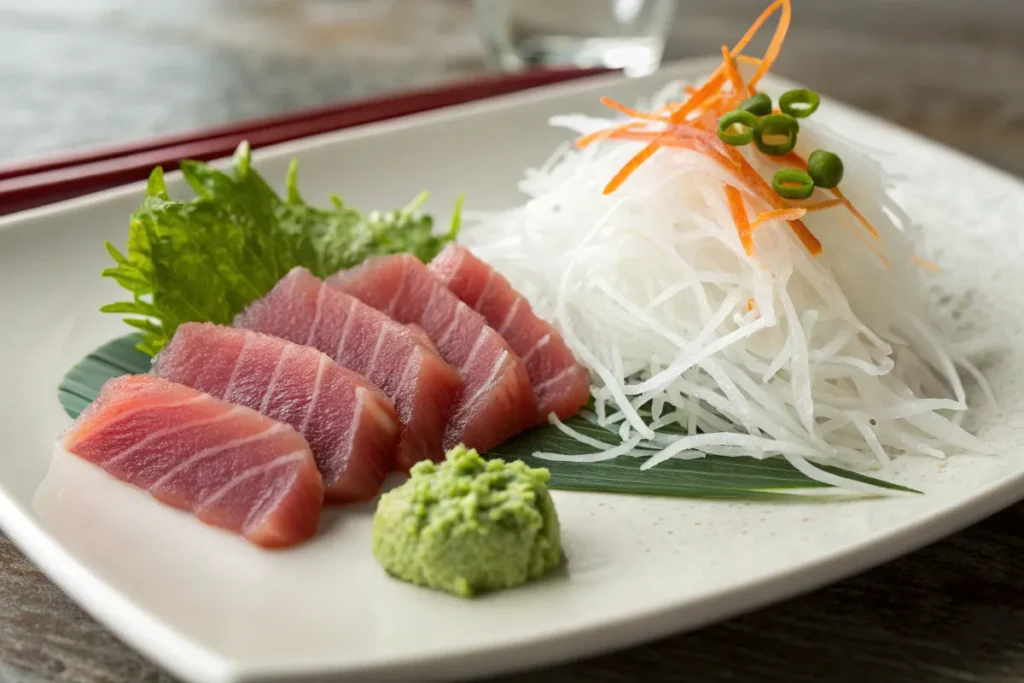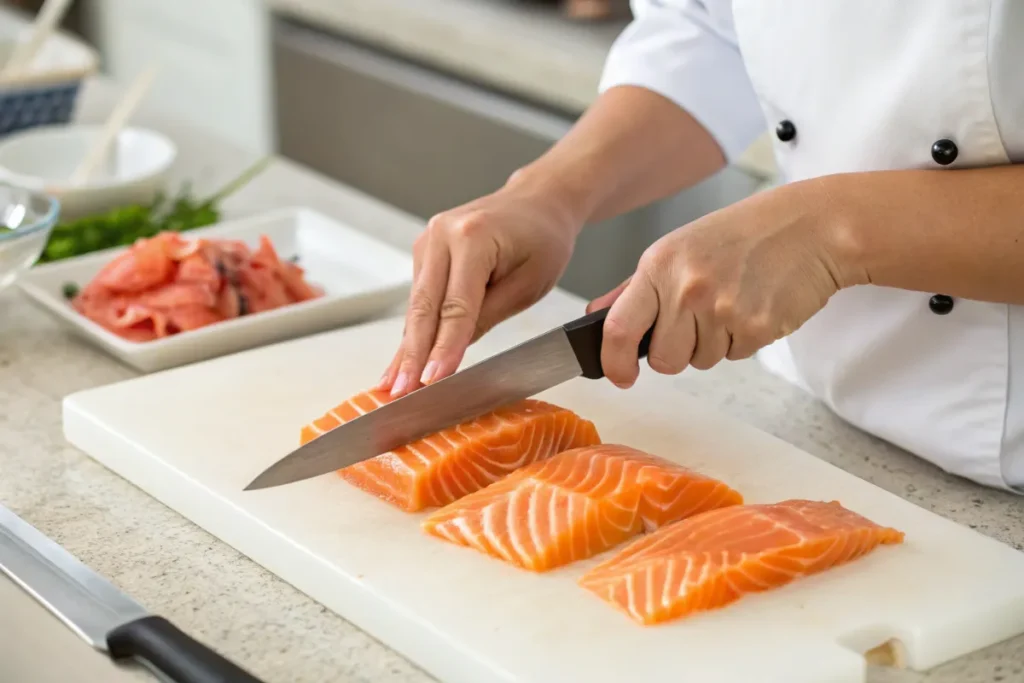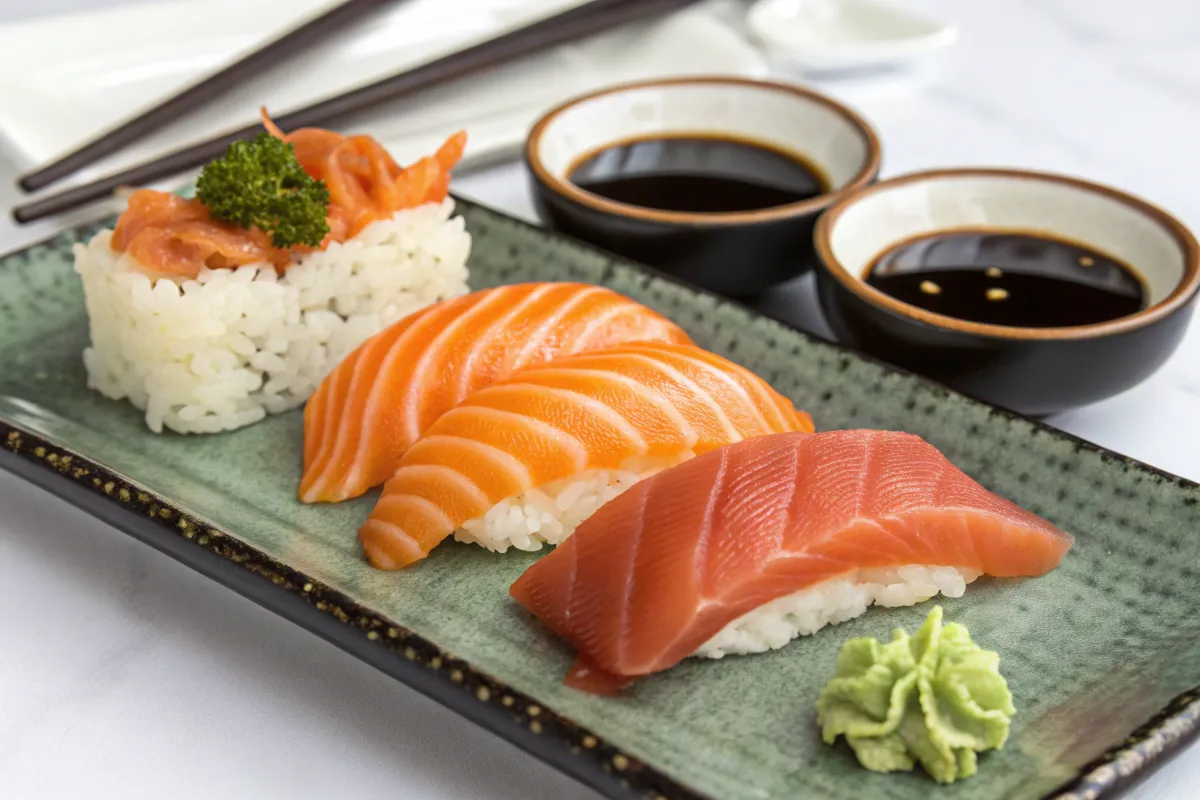Written by Sarah Miller
Nigiri and Sashimi are siblings of the sushi family. They’re similar yet wholly distinct. While both showcase the fine art of Japanese food, they differ in how they’re made, served, eaten, and consumed. If you’ve been wondering about the ways these two staples of sushi differ (and which one best suits your taste), this guide will help you.
You’ll be aware of:
- What Is The Difference Between Nigiri And Sashimi?
- Their nutritional benefits (because sushi, yes, is healthy! ).
- How can you please your friends at the restaurant the next time sushi is available?
Let’s dive in!
A Quick Overview of Nigiri and Sashimi
Before we dive into the specifics, let’s give a quick introduction to both.
What Is Nigiri?

People first think of Nigiri when they hear the word sushi. It’s the perfect bite-sized rice served with fresh seafood, usually raw fish such as tuna or salmon. There’s often a splash of wasabi hidden under the fish, and sometimes, an elongated strip of seaweed is wrapped around the fish to add a touch of elegance. It’s elegant, simple, and so satisfying.
What Is Sashimi?

Sashimi does not include rice and concentrates on the show’s main focus, the fish. It’s thinly sliced raw fish (or occasionally other meats like Octopus or beef) served on a beautiful plate. It’s all about taste, texture, and freshness. Sashimi may look simple, but believe me, it’s the most authentic method of tasting high-quality seafood.
In a nutshell, Nigiri has rice, and Sashimi doesn’t. Simple enough to remember.
Key Differences Between Nigiri and Sashimi
In the case of sushi and Nigiri, the devil lies in the small details. Both are popular sushi dishes; however, they could not be more different in how they are served, the ingredients used, and even how they’re served.
Presentation
Nigiri is about balance and visually pleasing, thanks to its compact shape. There’s a neat pile of rice sushi topped with fresh fish. It is often coated gently with soy sauce or garnished with a tiny piece of seaweed. Sashimi, in contrast, is simple in its approach. It’s usually served in a sequence of thinly cut fish, typically garnished with shredded daikon radish, shisho leaves, or edible flowers.
Ingredients
Nigiri adds rice to the mix. Nigiri rice comes cooked using vinegar and a pinch of sugar to give it that famous taste of tangy sweetness. On the top are cooked or raw seafood such as tuna, salmon, shrimp, and eel. Sashimi is a no-carb meal, all protein bliss. To increase the flavor, it’s a fish-based dish typically served with sauces such as wasabi, soy sauce, or ponzu sauce.
Flavor and Texture
Nigiri provides a mix of tastes, with the chewy texture of the fish and some sushi rice that is slightly sticky. Each bite is a delicate combination of rice and fish. Sashimi, in turn, emphasizes the fish’s characteristics. The flavors are stronger since there’s nothing that can alter the taste. It’s soft, silky, and perfect for those looking to taste the fresh fish in its purest shape.
Preparation
Nigiri requires a little skill. Chefs have to shape the rice to the correct size and shape. It must be firm enough to hold its shape but not too dense. They then top it off with perfectly cut fish. Sashimi preparation is a matter of knife proficiency. Cutting fish for Sashimi isn’t simply cutting; it’s an art. Chefs must make precise cuts that enhance the flavor and texture of the seafood.
The Art of Making Nigiri and Sashimi

Japanese chefs treat the procedure as a work of art when making sushi and Nigiri. Each step, from choosing the fish to the end product, is completed with great care and attention to detail. Here’s how each step is done.
Making Nigiri
Nigiri creation is about balance—literally! It begins with perfectly cooked sushi rice coated with sugar, vinegar, rice, and salt. The chefs shape the rice into oval-shaped mounds using their hands, ensuring that each piece is even and firm enough to keep its shape yet flexible enough to melt into your mouth.
The toppings of seafood such as tuna, shrimp, or salmon are cut carefully to blend seamlessly with the rice. A small amount of wasabi can be smuggled into the sushi for an extra zing. Sometimes, a small strip of nori (seaweed) is wrapped around to hold the topping, particularly for foods such as eel and tamago (sweet egg). ).
Preparing Sashimi
The preparation of Sashimi is when knife skills genuinely shine. The fish is cut into small, uniform pieces with a specially designed sushi knife. A clear, precise cut preserves the flavor and texture of the food. Depending on the type of fish, the chef may alter the slicing method to emphasize its unique characteristics, whether it’s the creamy softness of the salmon flesh or the firmness of the Octopus.
It is also important to present the food beautifully. Slices are typically placed on a platter with shredded daikon, Shiso leaves, or tiny heaps of wasabi. The aim is to make the dish visually attractive but keep the attention on the fish.
Tips for Enjoying Nigiri and Sashimi at Home
If you’re brave enough to make these at your home, here’s a few easy guidelines:
- For Nigiri, Buy high-end sushi rice and practice making it with your hands. It’s more complicated than it looks! Choose fresh fish from a reliable source, and ensure your knife is razor-sharp for precise cuts.
- For Sashimi For Sashimi: The fish must be sushi grade, which means it’s frozen to kill parasites. Slice it in cold slices. Don’t overlook serving it with garnishes for a truly authentic flavor.
health Benefits of Nigiri vs. Sashimi
Both Sashimi and Nigiri provide a healthy dose of nutrients. However, they are suited to different tastes in food and health objectives. Let’s look at the differences to help you figure out which one best fits your way of life.
Nutritional Comparison
- Nigiri: Because rice is added, Nigiri is an excellent source of carbohydrates and protein. It is spiced with sugar, vinegar, and salt, which makes it slightly more carb-rich than Sashimi. This makes it complete. However, it has slightly more calories.
- Sashimi is Pure protein, simple, and straightforward. Since it’s seafood or fish, Sashimi is naturally low in carbs and calories. It’s also perfect for those who follow keto, paleo, or low-carb diets.
Calorie Breakdown
- Nigiri is a typical portion of fish that is about 40-60 calories, depending on the kind of fish used and the amount of rice. Tuna and salmon tend to be slim, whereas tempura shrimp or eel could increase the calories.
- On the contrary, Sashimi averages around 25 – 40 calories per piece. Because it does not contain rice, it is a healthier choice if you’re trying to reduce your calorie intake.
Omega-3 Benefits
Sashimi and Nigiri contain fantastic amounts of Omega-3-rich fatty acids, which are suitable for the brain and heart and reduce inflammation. Fatty fish, such as mackerel, salmon, and tuna, are abundant in omega-3s.
Perfect for Different Diets
- Nigiri is an excellent choice for people seeking a balanced diet with protein and carbohydrates. It is nourishing but not overly heavy.
- Sashimi is excellent for protein lovers who want a low-calorie and carb-free option.
Sodium Watch
If you’re trying to watch your sodium intake, you should know that soy sauce may add a significant amount of salt to your meals. When eating sushi or Nigiri, go for low-sodium sauces or eat them without a dip to get a healthier alternative.
Popular Types of Nigiri and Sashimi
In the case of sushi and Nigiri, there is a variety of life! Both have a broad range of choices to satisfy every flavor, from subtle flavors to powerful, rich, and intense textures. Here’s a look at a few of the most sought-after varieties of each.
Nigiri Favorites
- “Salmon (Sake): A favorite with the crowd due to its creamy texture and mild taste.
- Tuna (Maguro) The HTML0 Tuna is a traditional choice often served fresh or lightly seared.
- Shrimp (Ebi) Shrimp is served cooked. Nigiri is sweet and has a slightly stiff texture.
- Egg (Tamago): A sweet, fluffy layer of egg omelets with a rice base. Perfect for those who are just beginning to learn about sushi.
- Eel (Unagi) is often grilled and glazed with a sweet soy sauce. Unagi nigiri has a caramelized, smoky flavor.
- Yellowtail (Hamachi): A delicate fish with a slightly rich flavor that is delicious when paired with the tangy taste of sushi rice.
Top Sashimi Choices
- Salmon: Rich in omega-3s, salmon sashimi melts in your mouth.
- Tuna is a favorite for its savory texture and crisp, bold flavor.
- Yellowtail It is frequently valued for its balance of tenderness and delicate flavor.
- Octopus (Tako) is a more robust option that cuts thinly for an enjoyable, chewy bite.
- Mackerel (Saba) is a delicious oily fish with a punchy flavor. It is often served with ginger to offset its sweetness.
- Scallop (Hotate) Soft and sweet, scallop Sashimi is a delectable delight.
Seasonal Variations
One of the greatest pleasures of sushi is its connection with the seasons. Certain types of fish are better at certain seasons:
- The winter months are here! The fat fish such as salmon and tuna are at their highest.
- Spring: Leaner, lighter fish like snapper and flounder gain popularity.
- Summer: Delicate fish like halibut shine in warmer months.
- The fall season: Mackerel as well as other oily, rich fish are plentiful and delicious.
How to Pair Nigiri and Sashimi Like a Pro
Whether you’re a novice or a veteran of sushi, mixing drinks, condiments, and even Sashimi and Nigiri can enhance the overall dining experience. Let’s examine some expert ways to make each bite memorable.
Condiments and Sauces
- Soy Sauce: A classic option for both Nigiri and Sashimi. Be sure to dip the fish in (not in the rice) to avoid overpowering the rice’s delicate flavor.
- Wasabi: A small amount on your Sashimi, or between the fish and rice in Nigiri, will add the perfect spice. Tips: Blend wasabi in soy sauce in a small amount. It’s not a traditional recipe, but it is common in casual restaurants!
- Ponzu Sauce: This citrusy and tangy sauce beautifully complements the freshness of Sashimi. It’s incredibly delicious with lighter fish like snapper or flounder.
- Pickled ginger: Cleans your taste buds between bites so you can enjoy every fish’s distinctive flavors.
Drink Pairings
- Sake: This classic Japanese rice wine pairs well with Sashimi and Nigiri. For a balanced tasting experience, choose a dry sake paired with Sashimi and a sweeter sake with Nigiri.
- Green Tea: Cleansing and refreshing green tea balances the sweetness of fish. It’s an essential ingredient in sushi restaurants and for good reasons.
- White Wine Dry, crisp white wine, such as Sauvignon Blanc or a sweet Riesling, is a great match for sushi.
- Beer Light Lagers or Japanese beers such as Asahi and Sapporo are great alternatives for a relaxed atmosphere.
Sushi Etiquette Tips
- Nigiri Nigiri: Feel at ease using your hands! Grab the fish with your hands, dip the fish’s side (not that rice) into soy sauce, and then eat it all in one bite.
- Sashimi Chopsticks are the best way to grab sashimi pieces and dip them lightly in your favorite sauce.
- Running: Sushi isn’t a race. Enjoy the flavors and textures of each item.
Complementary Sides
- Miso Soup is a Warm, comfortable start to any sushi dish.
- Seaweed Salad is light and refreshing, perfect for balancing the richness of salmon.
- Edamame is a Simple salty snack that goes well with the crisp taste of sushi.
Common Misconceptions About Nigiri and Sashimi
Even among sushi lovers, Sashimi and Nigiri are frequently confused. Let’s dispel many misconceptions and myths surrounding these two popular Japanese dishes.
“Nigiri is just sashimi on rice.”
Not quite! Sashimi is a term that refers to slices of raw fish that are thinly cut, and Nigiri is the art of carefully shaping sushi rice topped with fish. The rice used in Nigiri isn’t just a basis; it’s an integral part of the overall flavor. It is seasoned with vinegar to give an astringent, sweet taste that goes well with the fish.
“Sashimi is always fish.”
Surprisingly, no! Although fishing is the most commonly used protein, Sashimi could contain additional ingredients like beef (gyu-tataki), chicken (tori-sushi), and even tofu. The most important thing to remember is that Sashimi is thinly cut fresh or slightly cooked proteins, not the protein type itself.
“Sashimi must be raw.”
Not necessarily. Although most Sashimi is cooked, some choices, like Octopus (tako) and shrimp (ebi), are blanched or cooked. The focus of Sashimi lies in the quality of the preparation and presentation and the strict rawness.
“You can’t eat nigiri or sashimi with your hands.”
Sashimi is usually eaten with chopsticks. However, it’s perfectly fine to eat it by hand—in fact, it’s even encouraged! Using your hands can help preserve the delicate structures of fish and rice.
“Sashimi and nigiri are expensive everywhere “
Although premium sushi restaurants are costly, there are affordable alternatives at casual sushi bars, or you can make them at home. The price is mainly based on the high end and rarity of the fish used.
” Nigiri and sashimi are only for raw fish lovers .”
But that’s not the case! If you’re not a fan of raw fish, there’s a wide range of cooked nigiri choices, such as eel (unagi) eggs (Tamago) as well as shrimp (ebi). Similar to Sashimi, alternatives such as lightly seared and cooked Octopus provide an array of options for people who are hesitant to eat.
FAQs About Nigiri and Sashimi
What is the biggest difference between nigiri and sashimi?
The biggest difference is that nigiri includes sushi rice topped with seafood, while sashimi is just thinly sliced fish or other proteins served without rice.
Why is nigiri cheaper than sashimi?
Nigiri is often cheaper because it includes sushi rice, which makes it more filling and reduces the need for larger portions of fish. Sashimi requires high-quality cuts of fish and focuses solely on the seafood, which raises the cost.
Does sashimi mean no rice?
Yes, sashimi refers to thinly sliced fish or other proteins served without rice. It is served purely as the protein, often with garnishes like daikon radish or shiso leaves.
Is nigiri always raw?
No, nigiri is not always raw. While raw fish like tuna and salmon are common, cooked options like shrimp (ebi) and grilled eel (unagi) are also popular choices.
Do you eat nigiri in one bite?
Yes, nigiri is designed to be eaten in one bite to enjoy the perfect balance of rice and fish. It’s considered proper etiquette in sushi dining.
Why is sashimi so expensive?
Sashimi is expensive because it uses premium cuts of fish, often requiring the highest level of freshness and quality. The preparation also demands skilled knife work and attention to detail.
Conclusion
In Japanese food, sushi and Nigiri are in the bar serving sushi. Although they have some commonalities, their distinct features create unique experiences for those who love sushi.
Nigiri combines sushi rice’s tart, sweet taste with fresh seafood to create balanced, nutritious food. However, Sashimi is all about enjoying the taste and texture of top-quality fish in its purest form.
Whether you’re a rice or veg-oholic fan, something is enchanting about both meals. When you next visit the sushi bar, you’ll know the difference and be able to order like a pro.
And now, let us ask you: Do you prefer nigiri or team sashimi? Perhaps both? Leave a comment to let us know which one you like!

Nigiri and Sashimi Overview
Ingredients
For Nigiri
- 1 cup Sushi rice High-quality sushi rice is recommended.
- 1 tablespoon Rice vinegar To season the rice.
- 1 teaspoon Sugar For flavoring.
- 1 teaspoon Salt For seasoning.
- 200 grams Fresh fish (tuna, salmon, shrimp, or eel) Cut into thin slices.
- 1 piece Nori (seaweed) Optional, used for wrapping certain toppings.
- 1 teaspoon Wasabi Optional, can be added for flavor.
For Sashimi
- 200 grams Sushi-grade fish (salmon, tuna, octopus, or mackerel) Fresh and thinly sliced.
- 1 teaspoon Shredded daikon radish For garnish.
- 1 teaspoon Shiso leaves For garnish.
- 1 teaspoon Wasabi For dipping.
- 2 tablespoons Soy sauce For dipping.
Instructions
Preparation of Nigiri
- Rinse the sushi rice under cold water until the water runs clear.
- Cook the rice according to package instructions, then let it cool.
- Mix rice vinegar, sugar, and salt in a small bowl. Gently fold this mixture into the cooled rice.
- Shape the seasoned rice into small oval mounds using your hands.
- Top each mound with a slice of fresh fish. Add a small amount of wasabi if desired.
- Wrap with a strip of nori if using eel or tamago.
Preparation of Sashimi
- Ensure the fish is sushi-grade and sliced very thinly for optimal texture.
- Arrange the sashimi on a platter, garnished with shredded daikon and shiso leaves.
- Serve with soy sauce and wasabi on the side.
